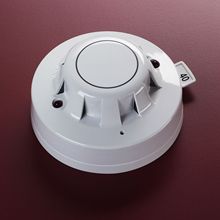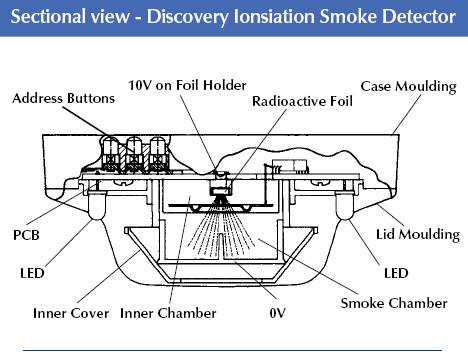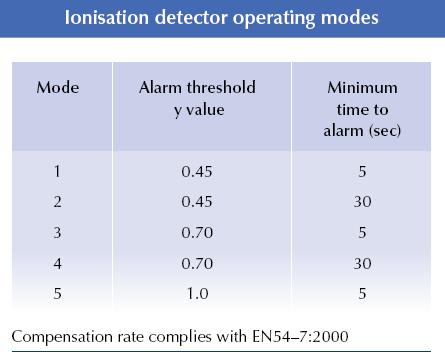DISCOVERY, Детекторы дыма ионизационные, 58000-500
 | Детекторы дыма ионизационные, |
Operating Principles
The Discovery Ionisation Smoke Detector uses the same outer case as the optical smoke detector and is distinguished by the red indicator LEDs. Inside the case is a printed circuit board which has the ionisation chamber mounted on one side and the signal processing and communications electronics on the other.
The ionisation chamber consists of a reference chamber contained inside a smoke chamber (Fig. 4). The outer smoke chamber has inlet apertures fitted with insect resistant mesh.
At the junction between reference and smoke chambers, the sensing electrode converts variations in chamber current into voltage changes.
When smoke particles enter the ionisation chamber, ions become attached to them with the result that the current flowing through the chamber decreases. This effect is greater in the smoke chamber than in the reference chamber, and the imbalance causes the sensing electrode to become more positive.
The analogue voltage at the sensor electrode is converted to a digital format which is processed to provide an analogue value for transmission to the control panel when the device is polled.
The Discovery Ionisation Detector, like all ionisation detectors, has some sensitivity to air movement (wind). The extent to which the analogue value will change depends on the wind speed and on the orientation of the detector relative to the wind direction. Relatively small changes in wind direction can cause significant changes in analogue value.
For wind speeds up to 1m/s (200ft/min) the change in analogue value will not exceed 5 counts. Continuous operation in wind speeds greater than 2m/s (400ft/min) is not recommended. However, wind speeds up to 10m/s (2000ft/min) can be tolerated for short periods and will not under any conditions increase the probability of false alarms.
Ionisation smoke detectors are supplied in individual packing with a red lid serving as a dust cover which can be left in place after fitting to prevent ingress of dust and dirt until commissioning of the system takes place.
At this point the covers must be removed.
SAFETY NOTE
In the United Kingdom, ionisation smoke detectors are subject to the requirements of the Radioactive Substances Act 1993 and to the Ionising Radiations Regulations 1999 made under the provisions of the Health and Safety at Work Act 1974.
The detectors, independently tested by the Health Protection Agency (HPA), conform to all the requirements specified in the ‘Recommendations for ionisation smoke detectors in implementation of radiation standards’ published by the Nuclear Energy Agency of the Organisation for Economic Co-operation and Development (OECD) 1977.
There is no limit to the number of ionisation smoke detectors which may be installed in any fire protection system.
Storage regulations depend on local standards and legislation, but, in the UK, up to 500 detectors may be stored in any premises, although there are stipulations on storage facilities if more than 100 ionisation detectors are stored in one building.
At the end of their recommended working life of ten years, ionisation smoke detectors should be returned to Apollo for safe disposal.
Guidance on storage and handling can be given by Apollo Fire Detectors and full details can be requested from:
Radioactive Substances Regulation Function Environment Agency Rio House, Waterside Drive Aztec West, Almondsbury Bristol BS32 4UD.
Outside the UK, please contact the relevant national agency.
Notes:
- This applies only to panels which have been programmed to read the additional information.
- In situ testing of the Multisensor detector should be carried out as for smoke detectors in response mode 2 and for heat detectors in response mode 5. Both optical and heat sensors must be tested in modes 1,3 and 4.
- If the Multisensor is to be used in mode 5, heat detector spacing/coverage should be applied.
ТЕХНИЧЕСКИЕ ХАРАКТЕРИСТИКИ
| Detection principle: | Ionisation chamber |
| Chamber configuration: | Twin compensating chambers using one single sided ionising radiation source |
| Supply wiring: | Two-wire supply, polarity insensitive |
| Radioactive isotope: | Americium 241 |
| Activity: | 33.3 kBq, 0.9μCi |
| Terminal functions: | L1 & L2 supply in and out connections +R remote indicator positive connection (internal 2.2kΩ resistance to positive) –R remote indicator negative connection (internal 2.2kΩ resistance to negative) |
| Operating voltage: | 17–28V DC |
| Communication protocol: | Apollo Discovery 5–9V peak to peak |
| Quiescent current: | 300μA |
| Power-up surge current: | 1mA |
| Maximum power-up time: | 10s |
| Alarm current, LED illuminated: | 3.5mA |
| Remote output characteristics: | Connects to positive line through 4.5kΩ (5mA maximum) |
| Clean-air analogue value: | 23 +4/–0 |
| Alarm level analogue value: | 55 |
| Alarm Indicator: | 2 colourless Light Emitting Diodes (LEDs); illuminating red in alarm. Optional remote LED |
| Temperature range: | –30°C to 70°C |
| Humidity: | 0 to 95% relative (no condensation or icing) |
| Effect of atmospheric pressure: | Less than 10% change in sensitivity over rated range |
| Atmospheric pressure: | Operating: Suitable for installation up to 2,000m above sea level. |
| Effect of wind: | Less than 20% change in sensitivity at speeds up to 10m/s. Note: slow changes in ambient conditions will automatically be compensated and will not affect sensitivity |
| Vibration, Impact and Shock: | To EN54–7:2000 |
| IP rating: | 44 in accordance with BSEN60529 |
| Dimensions: | 100mm diameter x 42mm height 50mm (height in base) |
| Weight: | Detector 105g Detector in base 160g |
| Materials: | Housing: White polycarbonate V–0 rated to UL94 Terminals: Nickel plated stainless steel |

